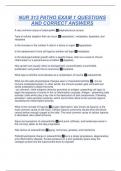NUR 313 PATHO EXAM 1 QUESTIONS
AND CORRECT ANSWERS
A very common cause of ostemyelitis ✅staphylococcus aureus
Type of cellular adaption that can occur ✅hyperplasia , metaplasia, dysplasia, and
neoplasia
Is the increase in the number if cells in a tissue or organ ✅hyperplasia
Is the replacement of one cell type by another cell type ✅metaplasia
Is the deranged cellular growth within a specific tissue, often as a result of chronic
inflammation or a precancerous condition ✅dysplasia
New growth and usually refers to disorganized, uncoordinated, uncontrolled,
proliferation cell growth that is cancerous ✅neoplasia
What type of arthritis could develop as a complication of trauma ✅osteoarthritis
What are the patio physiological changes seen in rheumatoid arthritis ✅- it is an
immune modulated system, in other words, the immune system gets confused and
sends antibodies to attack the joints
- an unknown, initial antigenic stimulus provoked an antigen- presenting cell (apc) to
begin the sequence of events in the ra inflammation cascade. Antigen - presenting cells
activate t cells which play a key role in the destruction of joint components. Following
activation t cells secretes cytokines, which recruit other wbcs to the synovial regions,
escalating the inflammation process.
What is the concept of hypoxia ✅oxygen deprivation, also known as hypoxia, is the
most common cause of cell injury. Cellular hypoxia commonly results when the blood
cannot deliver enough oxygen to the cells. The most common cause of cellular hypoxia
is dismissed, also called ischemia
Signs and symptoms of osteoarthritis ✅joint point, stiffness, and tenderness worst in
the morning, better as the day progresses
Risk factors of osteoarthritis ✅aging, hormones, genetics, and mechanics
Pathophysiological change in osteoarthritis ✅oa is a slowly progressive, degenerative,
and inflammatory disease. Excess pressure on a joint gradually wears away the
cartilage surface and the subchondral bone is exposed
, Diagnosis for osteoarthritis ✅no specific lab test can provide do for oa, but biomedical
markers such as serum osteocalcin and hyaluronic acid levels can reflect the presence
of synovitis in earlier stages of the disorder
Rheumatoid arthritis signs and symptoms ✅joint pains, stiffness, tenderness and
systemic symptoms such as fever, myalgia, and fever
Rheumatoid arthritis risk factors ✅gender, aging, family history, obesity, smoking,
environmental exposure
Rheumatoid arthritis pathophysiological changes ✅the body's immune system attacks
its own synovial tissues, stimulating an inflammatory process that results in destruction
of cartilage, bone, tendons, and ligaments
Diagnosis for rheumatoid arthritis ✅the diagnosis is based on several clinical criteria
and laboratory tests. Clinical criteria include the presence of morning stiffness in the
joints, polyarthritis, which includes the hand joints, symmetrical arthritis: and
subcutaneous rheumatoid nodules for a minimum of 6 weeks
Osteomyleitis signs and symptoms ✅generalized symptoms of chills, fever and
malasia
Osteomyelitis risk factors ✅diabetes, smoking, high cholesterol/ hyperlipidemia
Osteomyelitis pathophysiological changes ✅healthy bones are normally resistant to
bacteremia because bones are not highly vascular, so infection is slow to develop
Osteomyelitis diagnosis ✅radionuclide bone scan demonstrates are of infection. Bone
biopsy needed for culture of infection
Osteoporosis signs and symptoms ✅low back pain, fractures of firearm, spine, hip,
progressive curvature of spine, loss of height
Osteoporosis risk factors ✅gender, age, family history, ethnicity, body size, calcium
deficiency, menopause, cigarette smoke, excessive alcohol intake, sedentary lifestyle,
use of specific mediation
Osteoporosis pathophysiological changes ✅reduction in bone density caused by
imbalance between osteoclast and osteoblasts
Osteoporosis diagnosis ✅dexa (dual- energy absorptiometry) measures the bone
density in the lumber spine and hips, the areas that most commonly suffer osteoporosis




